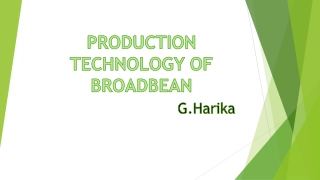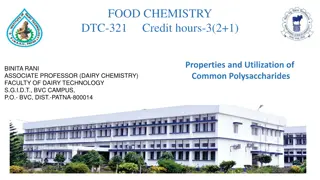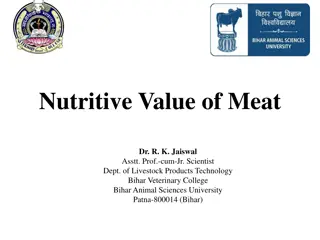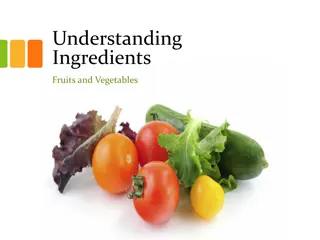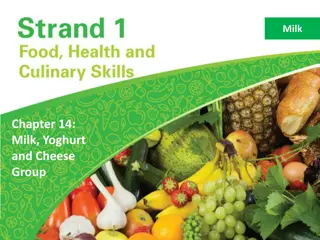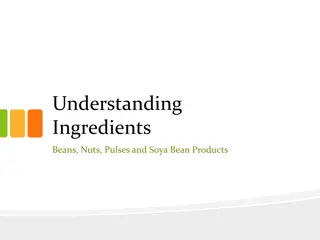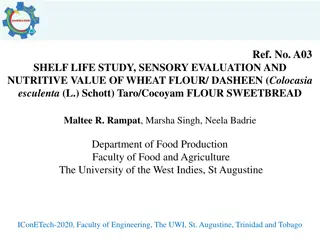Understanding Wholemeal Cereals and Their Nutritive Value
Exploring the world of wholemeal cereals including wheat, rice, maize, oats, barley, and rye. Learn about the nutritive and dietetic value of cereals, how cooking affects them, the structure of a cereal grain, and various products made from different cereals. Discover the importance of carbohydrates, fibre, proteins, vitamins, and minerals found in cereals, and how they contribute to a balanced diet.
Download Presentation

Please find below an Image/Link to download the presentation.
The content on the website is provided AS IS for your information and personal use only. It may not be sold, licensed, or shared on other websites without obtaining consent from the author. Download presentation by click this link. If you encounter any issues during the download, it is possible that the publisher has removed the file from their server.
E N D
Presentation Transcript
Cereals Chapter 13: Wholemeal Cereals and Breads, Potatoes, Pasta and Rice Group
What I Will Learn To classify cereals and give examples of each type To discuss the nutritive and dietetic value of cereals To explain how cooking affects cereals To describe the structure of a cereal grain To examine wheat and wheat products To examine potatoes and potato products To examine rice and rice products To describe products made from a variety of cereals
Wholemeal Cereals and Breads, Potatoes, Pasta and Rice Foods on this shelf are the best energy providers for your body, so the more active you are, the more you need. Choose any six or more servings each day for all ages, and up to 12 servings if you are active. Body size will also affect the number of servings a person should have per day.
What are the Main Cereals? The main cereals we use are: Wheat Rice Maize (corn) Oats Barley Rye
Graphic Organiser Complete the spider graphic organiser with products made from cereals. See Activity 13.4 in the TRB
Nutritive Value Carbohydrate is the main nutrient in cereals in the form of starch for heat and energy and fibre (8%) in the outer husk or bran layer if the grain is unprocessed (not milled). Cereals contain small amounts of LBV (low biological value) protein for growth and repair. Gluten is the main protein in wheat and rye. There is a small amount of polyunsaturated fat present in cereals, mainly in the germ.
Nutritive Value (continued) Cereals are an important source of B-group vitamins but processing removes these. Vitamin E is present in the germ of the grain. Minerals in cereal grains include calcium, iron and some phosphorus. Low water content means cereals have good keeping qualities and a long shelf life.
Dietetic Value Cereals are readily available, versatile and cheap to produce and buy. They are rich in starch so are an important energy food for all age groups. When unprocessed (wholegrain) they are rich in fibre, which aids digestion (how?). They provide unsaturated fat, which helps prevent cholesterol build-up.
Dietetic Value (continued) Wholegrains are a good source vitamin B (energy release), calcium (healthy bones and teeth) and iron (blood), so they are good for vegetarians. Coeliacs have an intolerance to gluten, so must avoid wheat, oats, barley and rye. Cereals are easy to store, prepare and cook with no waste.
Effects of Cooking on Cereals The cellulose softens and starch becomes more digestible, e.g. cooked rice or pasta becomes soft and easier to digest. Moist heat causes starch grains to burst, absorb moisture and thicken liquids, e.g. roux sauces. Dry heat causes starch grains to swell, burst and absorb fats, e.g. pastry, popcorn.
Structure of Cereal Grain All cereal grains have a similar structure. Wheat is the most widely grown cereal in the world. A wheat grain is composed of three main parts: i. Bran or husk (14%) is the outer layer and provides fibre, B-group vitamins and iron. It is usually removed during the processing of cereals. This process is known as refining. ii. Endosperm (84%) contains the energy store of the grain (mainly starch) and a protein called gluten. Coeliacs cannot absorb gluten. iii. The germ (2%) contains protein, fat and vitamin B and is the most nutritious part of the grain.
Flour Flour can be made from rice, maize, oats and rye, but the most common type is wheat flour. To produce flour, the cereal grains are milled or ground down. The production of white flour involves more refining than wholemeal flour (wholegrain), as the bran and germ are removed.
How Flour is Made 1 3: Grain is washed, dried and broken open between metal rollers. If the process stops here you have wholemeal flour. 4 5: Grain is sieved and rolled again and again, until the germ and bran are separated from the endosperm. 6 7: Air is blown through the flour to lighten it, and then extra ingredients are added to fortify it, e.g. calcium, B-vitamins. It may be bleached, too. 8: Finally, it is weighed and packed for sale. See Activity 13.5 in the TRB
Types of Flour Gluten- free flour Starch is washed out, leaving behind the protein gluten. Used to make products for coeliacs. Self- raising flour Raising agents sodium bicarbonate and cream of tartar are added to flour to make it rise when cooked. These react to heat and moisture, producing carbon dioxide. It keeps for about two or three months. Strong flour High gluten flour from spring wheat. It is used for yeast cookery and some pastries.
Types of Flour Wheatmeal/ brown flour (85% extraction) Some bran removed, light in texture, brown in colour, less fibre, B-group vitamins, keeps for up to two months Wholemeal flour (100% extraction) None of the grain is removed, light brown in colour, excellent source of B-group vitamins, protein and dietary fibre Bran and germ removed, the starchy endosperm and gluten remain, B-group vitamins, may be fortified with calcium and iron, keeps for up to six months White flour (70 75% extraction) plain or cream
Bread Bread is one of our staple foods. There is a wide variety of breads available from all over the world; a lot of supermarkets now have instore bakeries. Recently, there has been a big increase in the popularity of breadmaking at home. See Activity 13.6 in the TRB
Potatoes Potatoes are another staple food which is rich in starch, so they are included in this food group even though potatoes are technically root vegetables. How many different potato dishes can you name in one minute? They are a very versatile ingredient and are used in many ways in the diet.
Pasta Pasta is made from the endosperm (semolina) of durum wheat, which is mixed with water or egg to form a paste. The paste is pressed into different shapes and dried. Fresh pasta is partially dried and must be used within days. Dried pasta is fully dried and keeps for up to a year. Brown pasta is made with wholegrain semolina. Other ingredients can be used to add flavour and colour to pasta, e.g. adding spinach makes green pasta (pasta verde), adding tomatoes makes it red, squid ink makes pasta black. Fresh herbs like basil are also used.
Class Activities 1. Find out the names of as many different types of pastas as you can. 2. Watch this YouTube video to find out how pasta is made commercially. See Activity 13.8 in the TRB
Rice Rice is one of the world s most popular cereals and is grown in Asia, the USA and Italy. It contains less protein, fat and minerals than other cereals. Many varieties are now available that can be used for a range of sweet and savoury dishes.
Types of Rice Type Description Uses Short grain Short fat grain with a tender, sticky texture when cooked, sometimes called Carolina rice Sweet dishes, milk puddings Medium grain Narrow, between short and long grain rice. Grown in Italy Risotto, rice salads, puddings Long grain Very long, thin grain with a light, fluffy texture Savoury dishes, e.g. serve with curry, sweet and sour, casseroles Brown Some of the outer bran layer removed, takes longer to cook, rich in dietary fibre, minerals and vitamins Casseroles, curries, rice salads
Types of Rice (continued) Type Description Uses White Germ and bran removed Savoury dishes Arborio Plump rice with a soft moist texture when cooked Long grain rice grown in India good aroma, flavour and texture Risotto Basmati Indian and Middle Eastern dishes Savoury dishes Jasmine rice Long grain rice with nice aroma and flavour Easy-cook rice Long grain rice is steam treated so that it cooks quickly Savoury dishes
Types of Rice (continued) Type Description Uses Sushi Short grain rice that is sticky and slightly sweet Chewy outer sheath covering a nutritious grain inside and a nutty flavour. Grows on short stalks in shallow marsh water Sushi and other Japanese dishes Savoury dishes, pilau Wild
How is Rice Produced Watch this short YouTube video to learn how rice is produced.
Seeds Seeds include sesame seeds, sunflower seeds, linseeds, pumpkin seeds and poppy seeds. They are important in the diet because they are rich in omega, fatty acids, fibre and vitamin E. They also add colour, texture and variety. Can you suggest a variety of ways to include seeds in your diet?
Breakfast Cereals There is a wide variety of breakfast cereals made from different grains. They come flaked (corn, bran), shredded (wheat) and puffed (rice). Other ingredients are added, e.g. dried fruit, honey, nuts, cocoa, sugar and salt. They are often fortified with vitamins and minerals. The nutritive value depends on ingredients and the milk used. Porridge, muesli and high-bran cereals are good choices as they are rich in fibre. Those high in sugar and salt and should be avoided.
Cereals: Quick Revision 1. Explain what a cereal is and name six types of cereal. 2. Outline the nutritive and dietetic value of cereals in the diet. 3. Explain how cooking affects cereals. 4. Write an informative note on two of the following: i. Potato ii. Pasta iii.Rice iv.Seeds



